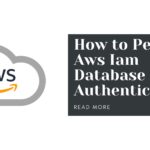AWS IAM Database: What Is It?
You can use AWS Identity and Access Management (IAM) database authentication to connect to your DB instance. MariaDB, MySQL, and PostgreSQL are all supported by IAM database authentication. When connecting to a database instance, you don’t need to use a password with this authentication mechanism. An authentication token is used instead.
An authentication token is a one-of-a-kind string of characters generated by Amazon RDS in response to a request. AWS Signature Version 4 is used to produce authentication tokens. Each token has a 15-minute lifespan. Because authentication is managed externally using IAM, you don’t need to store user credentials in the database. Standard database authentication can still be used. The token is only used for authentication purposes and does not affect the session once it has been established.
The following are some of the advantages of using IAM database authentication:
Secure Socket Layer (SSL) or Transport Layer Security is used to encrypt network communication to and from the database (TLS). See Using SSL/TLS to encrypt a connection to a DB instance for additional information on using SSL/TLS with Amazon RDS.
- Instead of managing access to each database instance manually, you may use IAM to centrally manage access to your database resources.
- For better security, you can utilize profile credentials specific to your EC2 instance to access your database instead of a password for apps running on Amazon EC2.
- We’ll go over how to use AWS Identity and Access Management (IAM) database authentication to authenticate your database instance. The AWS IAM service offers a “customer responsibility” layer of protection for your data, following AWS’ best practices of “shared accountability.”
Using Amazon Relational Database Service with AWS IAM (Amazon RDS)
Each person in your business who controls Amazon RDS resources should have their own IAM user. An IAM user can use the AWS Management Console to perform interactive operations and use the API or CLI to make programmatic queries to AWS services. Instead of using the long-term credentials associated with an IAM user, you can often use IAM roles and their temporary security credentials. For a given purpose, an IAM user can temporarily adopt a role to take on different rights.
IAM policies allow you to manage permissions for your workforce and systems, ensuring that only the least-privileged users have access. Attach a policy that specifies the type of access, the activities that can be performed, and the resources on which the actions may be conducted to grant permissions to IAM roles. For each request, IAM enforces those permissions. By default, access is forbidden; it is only given when permissions indicate “Allow.” Identity and access management (IAM) is a phrase that refers to all of the tools, processes, and policies that are used to manage user identities and control access within a company. Using the MySQL and PostgreSQL engines makes this capability available for databases. The workings of IAM are depicted in the diagram below.
Amazon RDS is a relational database that Amazon fully manages. As a result, AWS is in charge of the underlying infrastructure and foundation services. In addition to this, the operating system, database configuration, patching, and backups. AWS customers, on the other hand, are responsible for securing data stored in databases (through encryption and IAM access control) and managing application-specific database settings, creating the relational structure, and protecting network traffic. As a result, knowing when to use IAM and how to apply, it is critical.
Still Having Issues
Do you require assistance with data and analytics? We have the experience, AWS data, analytics expertise, and qualifications and research projects to assist you in planning and executing your strategy. We are a leading provider of AWS Cloud Consulting Services in the United States.




